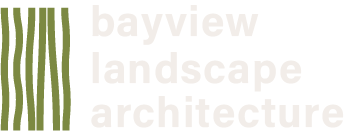Designing Resilient Futures
Nature-Based Solutions Take Center Stage at the ASLA-NY Climate Action Forum
As climate challenges accelerate—from rising seas to more frequent flooding—it’s clear that cities need solutions that don’t instinctively resist, but intelligently work with nature. Our Senior Landscape Architect, Gerrit Goss, attended the ASLA-NY Climate Action Forum, where experts across disciplines came together to spotlight how nature-based solutions are reshaping urban infrastructure and design. The central message was clear: resilience lies at the intersection of ecology and engineering. Whether it’s oysters filtering water or marshes slowing storm surges, the future of infrastructure is green, adaptive, and rooted in community.
From Controlling Nature to Collaborating with It
In the 20th century, infrastructure often meant domination—projects like the LA River or Hoover Dam were built to tame and control nature. But today, that mindset is shifting. Dr. Kyle McKay traced this evolution during the forum, emphasizing how resilient design is now moving from a “people or nature” mindset to “people and nature.” Ecological systems and infrastructure are no longer seen as opposing forces, but as partners on a continuum. From traditional engineering to living landscapes, the range of climate solutions is broader, more integrated, and increasingly driven by collaboration with the natural world.
Bio-concrete reef balls used by eDesign Dynamics to support biodiversity in the tidal salt marsh at Gansevoort Peninsula.
Living Infrastructure in Action
The Living Breakwaters project off Staten Island—launched after Hurricane Sandy—is a 2,400-foot system of ecologically-enhanced concrete structures that reduce wave energy and erosion while creating marine habitat. Gena Morgis of SCAPE emphasized how the design balances shoreline protection with long-term resilience.
In Queens, Rebecca Pryor of Guardians of Flushing Bay spotlighted community-led efforts to restore wetlands along Flushing Creek. Her team is advocating for Phoenix Meadow Park and empowering neighbors to care for local rain gardens through the Sidewalk Stewardship initiative.
On Manhattan’s west side, Nicholas Parisi of eDesign Dynamics described a tidal saltmarsh restoration at Gansevoort Peninsula that uses oyster cages and bio-concrete reef balls to improve water quality and support biodiversity within an urban park.
Further uptown, Jason Smith of the New York Restoration Project shared how volunteers built small breakwaters along the Harlem River to stabilize erosion—demonstrating how low-tech, nature-based solutions can restore wetlands and engage local communities.
Reforming Policy to Match Ecological Complexity
The final panel addressed one of the biggest barriers to large-scale restoration: regulation. Danielle Bissett of EPIC explained that today’s permitting systems—shaped by 1970s environmental laws—focus more on preventing harm than enabling restoration. But nature is dynamic, and our policies must evolve to support adaptive, forward-thinking solutions. Terry Doss, a restoration ecologist, raised ethical concerns about contaminated sites like the Hackensack River, a Superfund site where wildlife have returned to areas that appear healthy but remain toxic. She warned of the “attractive nuisance” effect, where the illusion of recovery can endanger ecosystems. Her message was urgent: restoration must go deeper than aesthetics and address root causes for lasting ecological health.
Toward a Climate-Just, Nature-Integrated Future
The ASLA-NY Climate Action Forum made it clear: landscape architects and ecologists aren’t just responding to climate threats—they’re actively reshaping how we think about infrastructure. By integrating nature into urban systems, we can build spaces that are not only resilient but also just, biodiverse, and deeply rooted in community.
Bayview is proud to learn from and be part of this movement. A heartfelt thank you to the forum’s speakers and organizers for continuing to lead the charge toward a climate-ready future—one that’s built to endure, adapt, and thrive.


